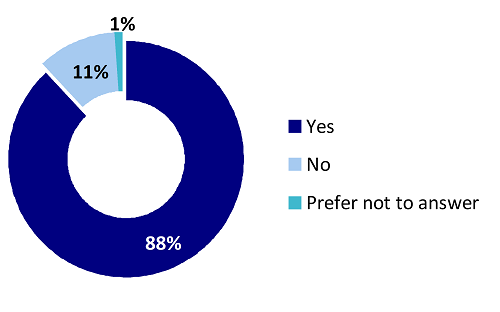
Chart 1 - Text description
| Total | |
|---|---|
| Weighted Total: | 2575 |
| Total: | 2575 |
| Yes | 88% |
| No | 11% |
| Prefer not to answer | 1% |
Findings Report
Prepared for Health Canada
Supplier: EKOS RESEARCH ASSOCIATES INC.
Contract Number: CW2333896
Contract Value: $80,704.60
Award Date: August 16, 2023
Delivery Date: February 27, 2024
Registration Number: HC POR 023-03
For more information on this report, please contact Health Canada at: hc.cpab.por-rop.dgcap.sc@canada.ca
Ce rapport est aussi disponible en français
Findings Report
Prepared for Health Canada
Supplier name: EKOS RESEARCH ASSOCIATES INC.
Date: February 2024
This public opinion research report presents the results of an online survey conducted by EKOS Research Associates Inc. on behalf of Health Canada. The research study was conducted with 2,575 Canadians in December 2023.
Cette publication est aussi disponible en français sous le titre : Points de vue de Canadiens et utilisations de produits de santé naturels, de médicaments sans ordonnance et de produits de santé contenant du cannabidiol.
This publication may be reproduced for non-commercial purposes only. Prior written permission must be obtained from Health Canada. For more information on this report, please contact Health Canada at hc.cpab.por-rop.dgcap.sc@canada.ca or at:
Health Canada, CPAB
200 Eglantine Driveway, Tunney's Pasture
Jeanne Mance Building, AL 1915C
Ottawa, Ontario K1A 0K9
Catalogue Number: H14-599/2024E-PDF
International Standard Book Number (ISBN): 978-0-660-71470-7
Related publications (registration number: POR 023-03
Catalogue Number: H14-599/2024F-PDF (French Report)
International Standard Book Number (ISBN): 978-0-660-71471-4
©His Majesty the King in Right of Canada, as represented by the Minister of Public Works and Government Services, 2024
Health Canada's Natural and Non-prescription Health Products Directorate (NNHPD) commissioned this online survey with Canadian consumers to assess the knowledge, attitudes, awareness, and behaviours concerning self-care products; specifically, natural health products (NHPs), non-prescription drugs (NPDs), and health products containing cannabidiol (HPCCs).
There is a plethora of self-care products marketed to Canadians which are available independent of the guidance of a health care practitioner or a prescription. Although some NHPs and NPDs have similar risk profiles, they are regulated differently, and consumers may view their risk differently.
As part of the Self-Care Framework, Health Canada is currently reviewing and updating the approach to regulating self-care products. Health Canada is working towards a risk-based approach to regulatory oversight of all self-care products and the current research will support future policy and regulatory approaches with respect to NHPs and NPDs.
The 2018 Cannabis Act allowed for the sale of cannabis for recreational purposes while maintaining access to cannabis for medical purposes and prescription drugs containing cannabis. Currently, the only legitimate route to market for a HPCC is as a prescription drug. However, illicit non-prescription HPCCs are available in stores and online, resulting in Canadians acquiring these unregulated products to treat ailments. A proposed regulatory approach for HPCCs will be informed by the recommendations provided by the Science Advisory Committee on Health Products Containing Cannabis, and would enable access to safe, effective and high quality HPCCs without a prescription.
The objectives of this research are to gather data on Canadian consumers' current level of knowledge, attitudes, awareness, and behaviours with respect to self-care products and to use the data to inform policy and regulatory approaches with respect to NHPs, NPDs and HPCCs.
The survey was conducted between December 5 and 19, 2023. The survey included 2,575 Canadians aged 18 and over. This randomly recruited probability sample carries with it a margin of error of +/-1.9%. The margin of error for key segments within each sample is between +/-5% and +/-10%. The sample source is an in-house Probit panel of randomly recruited Canadians and therefore results can be extrapolated to the population of Canadians who are 18 years of age or older. The survey instrument was delivered online (85%) as well as by telephone (15%) and available in both official languages. The average length of the survey was 13 minutes online and 18 minutes by telephone. The overall response rate for the survey was 12%. Appendix A presents further details on the methodology for the survey.
Detailed findings are presented in the sections that follow. Overall results are presented in the main portion of the narrative and are typically supported by graphic or tabular presentation of results. Bulleted text is also used to point out any statistically and substantively significant differences between sub-groups of respondents. If differences are not noted in the report, it can be assumed that they are either not statistically significant1 in their variation from the overall result or that the difference was deemed to be substantively too small to be noteworthy.
Results for the proportion of respondents in the sample who either said "don't know" or did not provide a response may not be indicated in the graphic representation of the results in all cases, particularly where they are not sizable (e.g., 10% or less). Results may also not total to 100% due to rounding. The programmed survey instrument can be found in Appendix B.
A number of definitions were provided to survey respondents. These included:
Natural Health Products (NHPs): Are made from naturally occurring ingredients that are used to restore or maintain health and can be purchased without a prescription in Canada. Examples of natural health products are vitamins, minerals, probiotics, herbal remedies, homeopathic products, and traditional medicines such as Traditional Chinese Medicine, Ayurvedic Medicine and Traditional Herbal Medicine. In addition, some toothpastes and hand sanitizers can also be classified as NHPs.
Non-prescription drugs (NPDs): Are also called over-the-counter drugs. These are health products that can be bought without a doctor's prescription. For example, certain pain relief medicine (oral or topical), cough and cold medicine, and allergy medicine.
Homeopathic products: A type of natural health product based on homeopathy which is a practice based on the principle that a disease and its symptoms can be cured by a product known to produce similar symptoms. For example, an ingredient such as Allium cepa (the common onion) would be indicated, after being prepared homeopathically, to relieve symptoms such as watering eyes and sneezing, since it can cause these symptoms in its unprocessed form. Homeopathic products are made of substances that come from plants, minerals, and animals and come in many forms such as pellets, oral droplets, syrups, creams and ointments.
Traditional medicine: Includes Traditional Chinese Medicine, Ayurvedic Medicine and Traditional Herbal Medicine. Traditional medicine refers to the knowledge, skills and practices based on the theories, beliefs and experiences indigenous to different cultures, used in the maintenance of health, as well as in the prevention, diagnosis, improvement or treatment of physical and mental illness.
Health Products Containing Cannabidiol: Refers to products containing cannabidiol (CBD) that would be marketed with health claims and would be intended to treat minor ailments similar to other natural health products and non-prescription drugs. These products would not require a prescription.
Other definitions can be found in the questionnaire in Appendix A.
I hereby certify as Senior Officer of EKOS Research Associates Inc. that the deliverables fully comply with the Government of Canada political neutrality requirements outlined in the Policy on Communications and Federal Identity and the Directive on the Management of Communications. Specifically, the deliverables do not include information on electoral voting intentions, political party preferences, standings with the electorate, or ratings of the performance of a political party or its leaders.
Signed by:

Susan Galley (Vice President)
Appendix A provides details of the sample characteristics in terms of region, size of community, age, sex, socioeconomic status and other key dimensions. Following are two additional considerations of the sample. All but a small proportion of the sample (12%) said that they are one of the primary decision-makers in the household when it comes to purchasing health products such as natural health products and non-prescription drugs.

| Total | |
|---|---|
| Weighted Total: | 2575 |
| Total: | 2575 |
| Yes | 88% |
| No | 11% |
| Prefer not to answer | 1% |
QD12. Are you the primary decision maker, or one of the primary decision-maker(s) in your household for the purchases of health products (e.g., non-prescription drugs, natural health products)?
Base: n=2575
One in four members of the sample (26%) indicated that they or someone in their household have a severe chronic condition and one in 10 (11%) indicated a severe or life-threatening allergy.
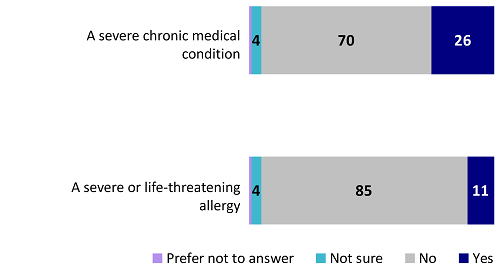
| Total | |
|---|---|
| Weighted Total: | 2575 |
| Total: | 2575 |
| Yes | 26% |
| No | 70% |
| Not sure | 4% |
| Prefer not to answer | 1% |
| Total | |
|---|---|
| Weighted Total: | 2575 |
| Total: | 2575 |
| Yes | 11% |
| No | 85% |
| Not sure | 4% |
| Prefer not to answer | 1% |
QD11a-b. Do you or does anyone else in your household have…?
Base: n=2575
Survey respondents were first asked if they use natural health products (NHPs), non-prescription drugs (NPDs), homeopathic products or traditional medicine. A definition was presented with each question (see Note to Reader or questionnaire in Appendix A). Close to three in four (73%) reported that they use NHPs, including vitamins and minerals. Two in three (65%) indicated use of NPDs, such as over the counter pain medications. Considerably fewer Canadians use homeopathic remedies (20%) or traditional medicines (14%).
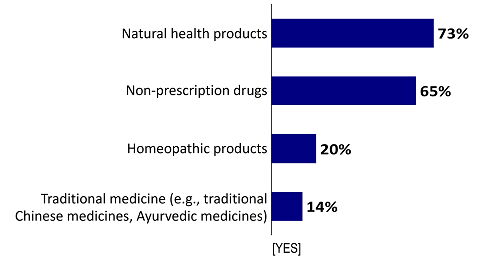
| Total | |
|---|---|
| Weighted Total: | 2575 |
| Total: | 2575 |
| Yes | 73% |
| No | 25% |
| Don't know / Prefer not to answer | 2% |
| Total | |
|---|---|
| Weighted Total: | 2575 |
| Total: | 2575 |
| Yes | 65% |
| No | 35% |
| Total | |
|---|---|
| Weighted Total: | 2575 |
| Total: | 2575 |
| Yes | 20% |
| No | 80% |
| Total | |
|---|---|
| Weighted Total: | 2575 |
| Total: | 2575 |
| Yes | 14% |
| No | 86% |
QUSEA-D. Do you use any of the following?2
Base: n=2575
Natural Health Products
Non-Prescription Drugs
Homeopathic Products
Traditional Medicine
Among those who indicate use of NHPs, NPDs, homeopathic products or traditional medicines, the most regular use is reported for NHPs, where 57% indicated daily use. Another 20% said they used these weekly or monthly. Among NPD users, 31% take them daily and another 21% use them weekly. Homeopathic products are similarly used by 33% daily and 16% weekly, and proportions are about the same among those who use traditional medicines (29% daily use; 14% weekly).
| Over the past 12 months, how frequently did you use each of the following products? | Non-prescription drugs (n=1693) |
Homeopathic products (n=493) |
Traditional medicine (n=359) |
Natural health products (n=1936) |
|---|---|---|---|---|
| Daily | 31% | 33% | 29% | 57% |
| Weekly | 21% | 16% | 14% | 14% |
| Monthly | 19% | 13% | 15% | 6% |
| Seasonally | 17% | 22% | 23% | 8% |
| Less than seasonally | 10% | 12% | 15% | 12% |
| Never | 1% | 3% | 2% | 0% |
| DK/Prefer not to say | 1% | 0% | 2% | 2% |
Natural Health Products
Non-Prescription Drugs
Other Products
All survey respondents were asked about the extent to which they feel they have the information they need about the risk and benefits of NHPs and NPDs. While just over half of Canadians (54%) feel they have considerable information (rating it a 4 or 5, where 5 is complete information) about NPDs, 29% feel they are only moderately informed and 12% said their information is limited (1 or 2 on the scale). Those who use NPDs are nearly twice as likely to feel informed (65%) compared with those who do not use them (34%).
Even fewer Canadians feel they have considerable information about the risks and benefits of NHPs (36%), while 29% feel they are moderately informed, and with almost as many saying they have limited information (27%). Those who use NHPs are almost three times more likely (43%) to feel informed compared with 16% among those who do not use these products. This rises to 48% among regular (e.g., weekly or more often) NHP users.

| Total | Users of NHPs | |
|---|---|---|
| Weighted Total: | 2575 | 1891 |
| Total: | 2575 | 1886 |
| LIMITED (1-2) | 27% | 21% |
| MODERATE (3) | 29% | 32% |
| CONSIDERABLE (4-5) | 36% | 43% |
| DK/Prefer not to answer | 8% |
| Total | Users of NPDs | |
|---|---|---|
| Weighted Total: | 2575 | 1681 |
| Total: | 2575 | 1693 |
| LIMITED (1-2) | 12% | 6% |
| MODERATE (3) | 29% | 28% |
| CONSIDERABLE (4-5) | 54% | 65% |
| DK/Prefer not to answer | 5% |
Q3a-b. To what extent do you feel that you have the information you need about the benefits and risks of the product when you buy…?
Base: n=2575
Natural Health Products
Non-Prescription Drugs
Nearly three in four Canadians (73%) agree that the NHP manufacturer is responsible for the safety of the product. This is particularly the case among those who use NHPs (76% compared with 64% of non-users). Only 10% disagree. Just over half (53%) agree that Health Canada is responsible, although 21% disagree and another 9% said they do not know. Only one in three (34%) agree that health claims must be true if they appear on the label, while 43% do not believe this to be the case. Users of NHPs are somewhat more likely to believe that claims on labels must be true (36% compared with 29% of non-users). Relatively few (19%) believe that a product is safer because it is made of natural ingredients, and even fewer non-users believe this to be the case (13% compared with 20% of NHP users).

| Total | |
|---|---|
| Weighted Total: | 2575 |
| Total: | 2575 |
| DISAGREE (1-2) | 49% |
| NEITHER AGREE NOR DISAGREE (3) | 29% |
| AGREE (4-5) | 19% |
| Don’t know/prefer not to answer | 3% |
| Total | |
|---|---|
| Weighted Total: | 2575 |
| Total: | 2575 |
| DISAGREE (1-2) | 10% |
| NEITHER AGREE NOR DISAGREE (3) | 11% |
| AGREE (4-5) | 73% |
| Don’t know/prefer not to answer | 6% |
| Total | |
|---|---|
| Weighted Total: | 2575 |
| Total: | 2575 |
| DISAGREE (1-2) | 21% |
| NEITHER AGREE NOR DISAGREE (3) | 17% |
| AGREE (4-5) | 53% |
| Don’t know/prefer not to answer | 9% |
| Total | |
|---|---|
| Weighted Total: | 2575 |
| Total: | 2575 |
| DISAGREE (1-2) | 43% |
| NEITHER AGREE NOR DISAGREE (3) | 20% |
| AGREE (4-5) | 34% |
| Don’t know/prefer not to answer | 4% |
Q4a-d. To what extent do you agree or disagree with the following statements?
Base: n=2575
The majority of respondents reported that they are confident or moderately confident (31% and 40% respectively) that NHPs are safe, effective and of quality, while 26% of respondents reported that they are not confident. Slightly higher proportions of NHP users are confident (37% compared with 14% of non-users). There is a large difference, however, between users and non-users of NHPs when it comes to a lack of confidence. While 48% of non-users said they are not confident, this is the case among only 18% of users.
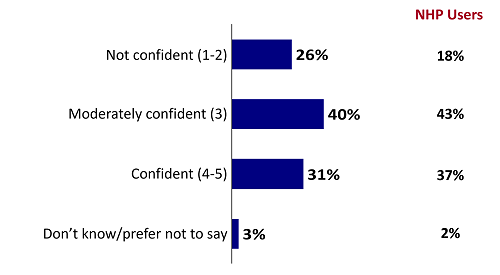
| Total | Users of NHPs | |
|---|---|---|
| Weighted Total: | 2575 | 1891 |
| Total: | 2575 | 1886 |
| NOT CONFIDENT (1-2) | 26% | 18% |
| MODERATELY CONFIDENT (3) | 40% | 43% |
| CONFIDENT (4-5) | 31% | 37% |
| Don’t know/prefer not to answer | 3% | 2% |
Q5. How confident are you that natural health products are safe, effective and of quality?
Base: n=2575
All respondents were asked about their location preferences for purchasing NHPs and NPDs, since even non-users may purchase them. Pharmacies are the most common location of purchase for both types of products (49% for NHPs and 73% for NPDs). In fact, 81% of the subset of Canadians who use NPDs4 say they most often purchase them at a pharmacy. This is also the case among 60% of the subset of Canadians who use NHPs5 who purchase these products at pharmacies. Grocery stores are the next most common location (30% for NHPs and 33% for NPDs), although this is slightly higher among the subset of Canadians who use these products, at 38% for each. While natural health foods stores are one of the retail locations to buy NHPs according to 27% (35% among NHP users), this is much less common when it comes to purchasing NPDs. Similarly, some Canadians purchase NHPs online (17%; 22% among NHP users), although few purchase NPDs online (8%). Other retail locations are much less common.
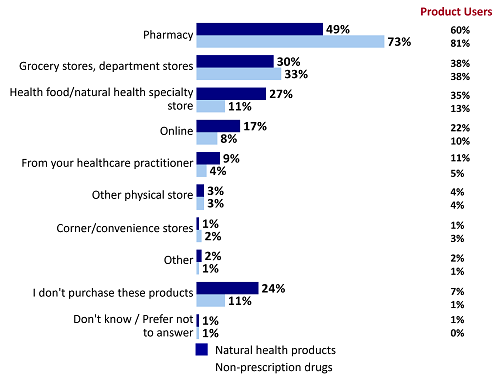
| Total | Users of NHPs | |
|---|---|---|
| Weighted Total: | 2575 | 1891 |
| Total: | 2575 | 1886 |
| Online | 17% | 22% |
| From your healthcare practitioner e.g., naturopath, acupuncture clinic etc. | 9% | 11% |
| Pharmacy | 49% | 60% |
| Health food/natural health specialty store | 27% | 35% |
| Grocery stores, department stores | 30% | 38% |
| Corner/convenience stores | 1% | 1% |
| Other physical store (please specify) | 3% | 4% |
| Other, specify | 2% | 2% |
| I don't purchase these products | 24% | 7% |
| Don't know / Prefer not to answer | 1% | 1% |
| Total | Users of NPDs | |
|---|---|---|
| Weighted Total: | 2575 | 1681 |
| Total: | 2575 | 1693 |
| Online | 8% | 10% |
| From your healthcare practitioner e.g., naturopath, acupuncture clinic etc. | 4% | 5% |
| Pharmacy | 73% | 81% |
| Health food/natural health specialty store | 11% | 13% |
| Grocery stores, department stores | 33% | 38% |
| Corner/convenience stores | 2% | 3% |
| Other physical store (please specify) | 3% | 4% |
| Other, specify | 1% | 1% |
| I don't purchase these products | 11% | 1% |
| Don't know / Prefer not to answer | 1% | 0% |
Q7. Where do you most often purchase your natural health products?
Q7b. Where do you most often purchase your non-prescription drugs?
Base: n=2575, right- hand column (Product Users) includes 1886 who use NHPs (shown next to dark blue lines), 1693 who use NPDs (next to light blue lines).
The most sought-after information about NHPs or NPDs when using a product for the first time is the directions of use, including the dosage, according to 82% overall (86% to 87% of NHP and NPD users). Purpose of the product and health claims are something that 69% look for (73% to 75% of product users), and warnings are of interest to the same proportion (68%; 72% to 73% of users). Six in ten (61%) also look for medicinal ingredients (65% to 68% of product users). Non-medicinal ingredients are also of interest to nearly half (47%: 49% to 53% of users). Other information such as directions for storage is also of interest to 42% (44% to 46% of users). Contact information of the responsible company is sought after by one in five (18% overall and 19% among product users).
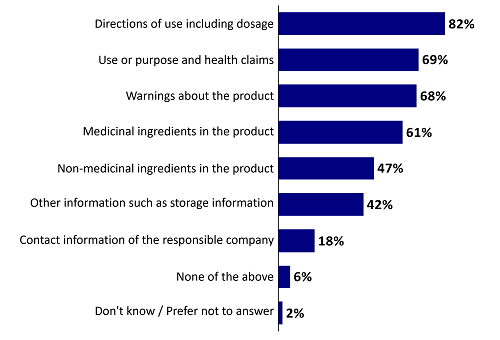
| Total | |
|---|---|
| Weighted Total: | 2575 |
| Total: | 2575 |
| Directions of use including dosage | 82% |
| Use or purpose and health claims | 69% |
| Warnings about the product (e.g., allergens, interactions with other products, etc.) | 68% |
| Medicinal ingredients in the product | 61% |
| Non-medicinal ingredients in the product | 47% |
| Other information such as storage information | 42% |
| Contact information of the responsible company (manufacturer/importer, etc.) | 18% |
| None of the above | 6% |
| Don't know / Prefer not to answer | 2% |
Q10. When purchasing health products such as natural health products or non-prescription drugs for the first time, what information do you look for on the label?
Base: n=2575
Among the 84% of Canadians with access to data on a cellphone, 25% said that they would be likely to use a QR code to access product label information in-store before purchasing a product (i.e., 21% of all Canadians6). Another 23% said that they would be moderately likely to do so.
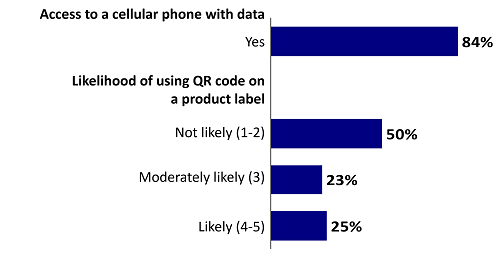
| Total | |
|---|---|
| Weighted Total: | 2575 |
| Total: | 2575 |
| Yes | 84% |
| No | 11% |
| Sometimes (it depends if I have reception at the store) | 4% |
| Don't know / Prefer not to answer | 1% |
| Total | |
|---|---|
| Weighted Total: | 2264 |
| Total: | 2242 |
| NOT LIKELY (1-2) | 50% |
| MODERATELY LIKELY (3) | 23% |
| LIKELY (4-5) | 25% |
Q12. Do you currently have access to a cellular phone with data (where you are able to browse websites without WiFi, for example, when you are at a store)?
Base: n=2575
Q13. How likely would you be to use a QR code on a product label (that brings you to information on a website) before purchasing a product in the store?
Base: n=2242 (note: only those that responded they have access to a cell phone with data (Q12) were asked this question)
Among the 50% who are unlikely to access product information through a QR code before purchase, 42% said that this is too time consuming and 20% said that they do not wish to use their phone in the store. Three in ten also feel it is too complicated (17%) or they do not know how to use a QR code (13%). Other reasons are much less common.
| Q14. Why would you not want to access a QR code? | Total n=1124 (those unlikely to access a QR code before purchase) |
|---|---|
| Too time consuming | 42% |
| I don't want to use my phone in the store | 20% |
| Looking at information on-line is too complicated | 17% |
| I don't know how to scan the code | 13% |
| Security/privacy concerns, malware, tracks info/interests, leads to scams | 7% |
| Research before I buy products, have done research on line before I purchase | 5% |
| No interest/no need | 5% |
| Website/link is biased, comes on a unreliable source/ manufacturer/company that makes it | 4% |
| Relevant/important information should be available on the label, prefer to read label | 4% |
| Just never occurs to me, do not always think about it | 3% |
| Phone limitations, cost of apps, lack of wifi/data plan, phone does not scan QR codes/does not always work/ reception is poor | 2% |
| Other | 5% |
| Don't know / Prefer not to answer | 7% |
All respondents were asked what product information they would want to access on a website through a URL or QR code, instead of on the physical product label. About one-quarter (24%) said they would not want to access product information through a URL or QR code. Half said they would want to use a URL or QR code to access information about warnings (54%), purpose and health claims (51%), and directions of use (50%). Those who previously indicated a likelihood to use a QR code are much more likely to want to access each of these types of information through a website or QR code compared to those who say they are not likely to use a QR code.
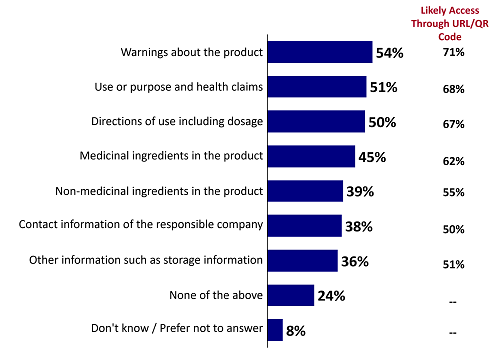
| Total | Likely to use QR code | |
|---|---|---|
| Weighted Total: | 2575 | 571 |
| Total: | 2575 | 552 |
| Directions of use including dosage | 50% | 67% |
| Use or purpose and health claims | 51% | 68% |
| Warnings about the product (e.g., allergens, interactions with other products, etc.) | 54% | 71% |
| Medicinal ingredients in the product | 45% | 62% |
| Non-medicinal ingredients in the product | 39% | 55% |
| Other information such as storage information | 36% | 51% |
| Contact information of the responsible company (manufacturer/importer, etc.) | 38% | 50% |
| None of the above | 24% | |
| Don't know / Prefer not to answer | 8% |
Q15. What information would you want to access through a website address (URL) or QR code indicated on the physical label instead of having the information on the actual physical label itself?
Base: n=2575
According to the survey, 8% of Canadians have experienced an adverse reaction to a NHP, and similarly, 9% have had a reaction to a NPD.7 Just over half of those experiencing a reaction did not report it (60% of those with a reaction to NHP and 53% with a reaction to a NPD). Among those with an adverse reaction, a health care practitioner is the most likely contact that Canadians report it to (20% among those with a reaction to a NHP and 35% among those with a reaction to a NPD). Other contacts for reporting are considerably less likely.
| - | Total Natural Health Products |
Total Non-Prescription Drug |
|---|---|---|
| PREQ19. In the past, did you have an adverse reaction to a natural health product? | n=2568 | n=2566 |
| Yes | 8% | 9% |
| Q19. Where did you report the reaction? | n=222 | n=245 |
| I had an adverse reaction but I did not report it | 60% | 53% |
| I reported my reaction to my healthcare practitioner | 20% | 35% |
| I reported my reaction to the store where I purchased the product(s) | 5% | 2% |
| I reported my reaction to the manufacturer | 2% | 1% |
| I reported my reaction to Poison control center | 1% | 1% |
| I reported my reaction to Health Canada (e.g., Canada Vigilance Adverse Reaction Online Database) | 0% | 1% |
| Other | 8% | 5% |
| Don't know / Prefer not to answer | 5% | 3% |
Three in ten Canadians (29%) said that they would be likely to purchase a health product containing CBD for minor ailments, if it were available without a prescription. On the other hand, nearly half (46%) said they would be unlikely to do so.
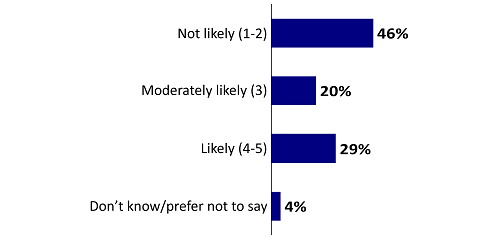
| Total | |
|---|---|
| Weighted Total: | 2575 |
| Total: | 2575 |
| NOT LIKELY (1-2) | 46% |
| MODERATELY LIKELY (3) | 20% |
| LIKELY (4-5) | 29% |
| Don’t know/prefer not to say | 4% |
Q21. If available without a prescription, how likely would you be to purchase a health product containing cannabidiol (CBD) to relieve minor ailments?
Base: n=2575
As for locations used to purchase NHPs and NPDs, eight in ten Canadians (82%) who said they would purchase CBD-based products would purchase the product at a pharmacy. Authorized cannabis dealers were also noted by 50%, while roughly one in three said they would go to a health food store (36%) or department or grocery store (31%). Fewer would rely on online retailers (15%) or a convenience store (10%).
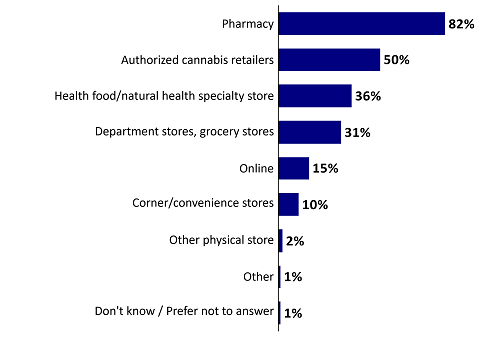
| Total | |
|---|---|
| Weighted Total: | 1279 |
| Total: | 1292 |
| Pharmacy | 82% |
| Health food/natural health specialty store | 36% |
| Authorized cannabis retailers | 50% |
| Grocery stores, department stores | 31% |
| Corner/convenience stores | 10% |
| Other physical store (please specify) | 2% |
| Online | 15% |
| Other (please specify) | 1% |
| Don't know / Prefer not to answer | 1% |
Q22. If health products containing cannabidiol (CBD) were available for sale without a prescription, where would you prefer to purchase the product?
Base: n=1292
The survey sample was drawn from our randomly recruited panel Probit. Probit panellists were selected using a random-digit dial (RDD) landline-cell phone hybrid sample frame. This is the same sample frame and sampling process used to conduct telephone surveys, which are considered to be representative of the population8. Once selected, they are contacted and recruited by telephone and asked to complete a basic profile (i.e., base survey instrument) including a range of demographic information about themselves. They are also asked if they would prefer to complete surveys online or by telephone. All sample members are eligible to participate, including those with cell phones only, those with no Internet access and those who simply prefer to respond by telephone rather than online. This panel represents a fully representative sample of Canadians, from which we can draw random samples and collect data in a more cost conscious and timely manner than would otherwise be possible in a traditional telephone survey. This panel of more than 120,000 individuals can be considered representative of the general public in Canada (meaning that the incidence of a given target population within our panel very closely resembles the public at large) and margins of error can be applied.
Prior to conducting the survey, the instrument was tested with 34 cases in English (24 cases) and French (10 cases). A total of 24 were conducted online and 10 were completed by telephone. Additional questions were placed on the pretest version of the questionnaire asking about length, flow, clarity of wording and so on to elicit feedback from respondents. Minimal changes were made as a result of the testing, although a few questions were removed in order to stay within the intended survey length.
The survey was administered between December 5 and 19, 2023, using a bilingual questionnaire, installed on a secure web-server controlled by EKOS. The email invitation included a description and purpose of the survey (in both languages) along with a link to the survey website. The survey database was mounted using a Personalized Identification Number (PIN), so only individuals with a PIN were allowed access to the survey (the PIN was included in the email invitation). The questionnaire was prefaced with a brief introduction to the study and rationale for the research. The voluntary and confidential nature of the survey was also emphasized. Survey data collection adhered to all applicable industry standards. All invited panel members were informed of their rights under current Privacy legislation, as well as how to obtain a copy of their response and results of the survey.
As shown below the average response rate overall across the 28,390 cases is 12.2%. It is 16.7% among Probit sample members who completed the survey online and 5.1%9 among those who completed the survey by telephone, including the cases completed or ineligible divided by the valid sample of 25,608 for online and telephone sample combined, as noted in the table below.
| Outcome | Online | Telephone | Total |
|---|---|---|---|
| Total | 17,133 | 11,257 | 28,390 |
| Invalid | 1,376 | 1,406 | 2,782 |
| Valid Sample | 15,757 | 9,851 | 25,608 |
| Non-responding | 13,129 | 9,353 | 22,482 |
| Refusal | 168 | 669 | 837 |
| Partial complete | 251 | 4 | 255 |
| Total non-response | 13,548 | 10,026 | 23,574 |
| Ineligible/quota filled | 436 | 115 | 551 |
| Complete | 2192 | 383 | 2,575 |
| Response rate | 16.7% | 5.1% | 12.2% |
Respondents were informed in the invitation that all responses are completely confidential and no responses will be linked to individual names.
The database was reviewed following data collection for data quality, outliers, coding requirements, weighting and construction of independent variables, and was used to explore sub-group patterns (e.g., by age, gender and so on) in the analysis. Weighting of the sample was based on population parameters according to the 2021 Census on age, gender and region of the country, as well as identifying as a member of the 2SLGBTQI+ community.
The following table presents a sample profile for the survey (unweighted for age, region, sex and 2SLGBTQi+ identity group, weighted for other characteristics).
| - | Total |
|---|---|
| Region (unweighted) | n=2275 |
| British Columbia | 12% |
| Alberta | 12% |
| Saskatchewan and Manitoba | 7% |
| Ontario | 36% |
| Quebec | 22% |
| Atlantic | 7% |
| Territories | 4% |
| Community Size | n=2151 |
| A city | 52% |
| A suburb | 22% |
| A rural area, small town or remote area | 26% |
| Age (unweighted) | n=2575 |
| Under 35 | 21% |
| 35 to 44 | 17% |
| 45 to 54 | 17% |
| 55 to 64 | 18% |
| 65 or older | 27% |
| Sex at birth (unweighted) | n=2575 |
| Male | 49% |
| Female | 48% |
| Gender (Currently identify as) | n=2575 |
| Male | 47% |
| Female | 50% |
| Non-Binary/other | 2% |
| Prefer not to answer | 1% |
| Identify as 2SLGBTQI+10 (unweighted) | n=2150 |
| Yes | 19% |
| No | 79% |
| Prefer not to answer | 2% |
| Other target groups | n=1244 |
| Trying to get pregnant | 2% |
| Breastfeeding | 2% |
| Pregnant | 1% |
| None of the above | 94% |
| Prefer not to answer | 1% |
| Caregiver to a parent or a child | n=2575 |
| Yes | 24% |
| No | 75% |
| Prefer not to answer | 1% |
| Ethnocultural group | n=2575 |
| White | 77% |
| Indigenous (First Nations, Inuk/Inuit, Métis descent) | 6% |
| South Asian (e.g., East Indian, Pakistani, Sri Lankan) | 5% |
| Black | 5% |
| Chinese | 3% |
| Latin American | 2% |
| Filipino | 1% |
| Arab | 1% |
| Southeast Asian (e.g., Vietnamese, Cambodian, Laotian, Thai) | 1% |
| West Asian (e.g., Iranian, Afghan) | 1% |
| Japanese | 1% |
| Canadian | 1% |
| European (various) | 1% |
| Other | 1% |
| Prefer not to answer | 2% |
| Born in Canada | n=2575 |
| Yes | 79% |
| No | 21% |
| Highest level of education | n=2575 |
| High school diploma or less | 28% |
| College, CEGEP or other non-university certificate or diploma | 25% |
| University certificate or diploma below bachelor's level | 7% |
| Bachelor's degree | 23% |
| Post graduate degree above bachelor's level | 16% |
| Prefer not to answer | 1% |
| Household income | n=2575 |
| Under $20,000 | 5% |
| $20,000 to just under $40,000 | 11% |
| $40,000 to just under $60,000 | 12% |
| $60,000 to just under $80,000 | 12% |
| $80,000 to just under $100,000 | 12% |
| $100,000 to just under $150,000 | 20% |
| $150,000 or more | 17% |
| Prefer not to answer | 11% |
Thank you for agreeing to complete this survey. This will only take about 10 minutes of your time.
Please rest assured that your answers are completely confidential (this means that no individual will be associated with the survey's results - rather, they will be rolled up into large categories to protect the confidentiality of each respondent) and that this survey is voluntary.
Please consider the questions and your answers carefully. Definitions for some terms can be viewed by hovering your mouse over the word.
On each screen, after selecting your answer, click on the "Continue" button at the bottom of the screen to move forward in the questionnaire.
If you leave the survey before completing it, you can return to the survey URL later, and you will be returned to the page where you left off. Your answers up to that point in the survey will be saved.
If you have any questions about how to complete the survey, please call EKOS at 1-866-211-8881 or email us at online@ekos.com. Thank you in advance for your participation.
PRED13
Do you or does anyone in your household work in the following industries?
D13A
Market research, public relations or advertising
D13B
Federal or provincial government
D13C
Drug, natural health product, or cannabis products companies
D13D
Consumer advocacy or industry association groups in the area of drugs
Q1
Over the past 12 months, how frequently did you use natural health products?
Natural Health Products (NHPs): Natural Health Products (NHPs) are made from naturally occurring ingredients that are used to restore or maintain health and can be purchased without a prescription in Canada. Examples of natural health products are vitamins/supplements, minerals, probiotics, herbal remedies, homeopathic products, and traditional medicines such as Traditional Chinese Medicine, Ayurvedic Medicine and Traditional Herbal Medicine. In addition, some toothpastes and hand sanitizers can also be classified as NHPs.
PREQUSE
Do you use any of the following:
QUSEA
Non-prescription drugs <HOVER=Also called over-the-counter drugs, are health products that can be bought without a doctor's prescription. For example, certain pain relief medicine (oral or topical), cough and cold medicine, and allergy medicine.>
QUSEB
Homeopathic products <HOVER=Are a type of natural health product based on homeopathy which is a practice based on the principle that a disease and its symptoms can be cured by a product known to produce similar symptoms. For example, an ingredient such as Allium cepa (the common onion) would be indicated, after being prepared homeopathically, to relieve symptoms such as watering eyes and sneezing, since it can cause these symptoms in its unprocessed form. Homeopathic products are made of substances that come from plants, minerals, and animals and come in many forms such as pellets, oral droplets, syrups, creams and ointments.>
QUSEC
Traditional medicine <HOVER=Include Traditional Chinese Medicine, Ayurvedic Medicine and Traditional Herbal Medicine. Traditional medicine refers to the knowledge, skills and practices based on the theories, beliefs and experiences indigenous to different cultures, used in the maintenance of health, as well as in the prevention, diagnosis, improvement or treatment of physical and mental illness.> (e.g., traditional Chinese medicines, Ayurvedic medicines)
PREQ2
Over the past 12 months, how frequently did you use each of the following products?
Q2A
Non-prescription drugs
Q2B
Homeopathic products
Q2C
Traditional medicine
PREQ3
To what extent do you feel that you have the information you need about the benefits and risks of the product when you buy…?
Q3A
natural health products
Q3B
non-prescription drugs
PREQ4
To what extent do you agree or disagree with the following statements?
Q4A
Q4B
The natural health product manufacturer is responsible for the safety of the product
Q4C
Health Canada is responsible for the safety of a natural health product
Q4D
Natural health product claims (for example: helps build strong bones and teeth) must be true if they are written on the label
Q5
How confident are you that natural health products are safe, effective and of quality?
Safe, effective and of quality: Health Canada assesses health products before letting them be sold in Canada. Companies must follow good manufacturing practices to ensure the products are properly manufactured (without contamination or incorrect ingredients). Health products should also achieve the expected health-related results or therapeutic effects when used by individuals.
Q7 [1,8]
Where do you most often purchase your natural health products?
Select all that apply
Q7B [1,8]
Where do you most often purchase your non-prescription drugs?
Select all that apply
Q10 [1,7]
When purchasing health products such as natural health products or non-prescription drugs for the first time, what information do you look for on the label?
Select all that apply
Q12
Do you currently have access to a cellular phone with data (where you are able to browse websites without WiFi, for example, when you are at a store)?
Q13
How likely would you be to use a QR code <HOVER=A machine-readable code consisting of an array of black and white squares, typically used for storing link to webpage or other information for reading by the camera on a smartphone.> on a product label (that brings you to information on a website) before purchasing a product in the store?
Q14 [1,5]
Why would you not want to access a QR code?
Select all that apply
Q15 [1,7]
What information would you want to access through a website address (URL) or QR code indicated on the physical label instead of having the information on the actual physical label itself?
Select all that apply
PREQ19
In the past, did you have an adverse reaction to a natural health product?
Q19
Where did you report the reaction?
PREQ19B
In the past, did you have an adverse reaction to a non-prescription drug?
Q19B
Where did you report the reaction?
Q21
The term "Health Products Containing Cannabidiol" refers to products containing cannabidiol (CBD) that would be marketed with health claims and would be intended to treat minor ailments <HOVER=Conditions that can initially be managed with non-prescription therapy. Some examples of minor ailments are relieving minor symptoms of stress and nervousness, promoting sleep, and relieving minor pain. This does not include treatment, cure and/or prevention of serious diseases (e.g., for the treatment of high blood pressure).> similar to other natural health products and non-prescription drugs. These products would not require a prescription.
Currently all health products containing cannabidiol that are legally available require a prescription. Health Canada is considering a regulatory proposal that would enable access to safe, effective and high quality health products containing cannabidiol that would not require the oversight of a practitioner (i.e., available without a prescription).
If available without a prescription, how likely would you be to purchase a health product containing cannabidiol (CBD) to relieve minor ailments?
Q22 [1,8]
If health products containing cannabidiol (CBD) were available for sale without a prescription, where would you prefer to purchase the product?
Select all that apply
QDEMO
The following demographic questions will be used in data analysis to support detailed analysis and better understand the data.
Privacy statement
<HOVER/DEFINITION=What about your personal information?
1. The personal information you provide to Health Canada is governed in accordance with the Privacy Act and is being collected under the authority of section 4 of the Department of Health Act in accordance with the Treasury Board Directive on Privacy Practices. We only collect the information we need to conduct the research project.
2. Purpose of collection: We require your personal information such as demographic information to better understand the topic of the research. However, your responses are always combined with the responses of others for analysis and reporting; you will never be identified.
3. For more information: This personal information collection is described in the standard personal information bank Public Communications – PSU 914, in Info Source, available online at infosource.gc.ca.
4. Your rights under the Privacy Act: In addition to protecting your personal information, the Privacy Act gives you the right to request access to and correction of your personal information. You also have the right to file a complaint with the Privacy Commissioner of Canada if you think your personal information has been handled improperly.>
D1
In which of the following age groups do you belong?
D2
What was your sex at birth <HOVER=Refers to the sex assigned at birth based primarily on physical and physiological features including chromosomes, gene expression, hormone levels and function, and reproductive/sexual anatomy.>?
D3
Which of the following best describes how you currently identify?
D3B
Do you identify as 2SLGBTQI+ <HOVER=Two-spirited, lesbian, gay, bisexual, transgender, queer, intersex, and the + is inclusive of people who identify as part of sexual and gender diverse communities, who use additional terminologies.>?
D4 [1,3]
Are you currently:
Select all that apply
D5
Are you a caregiver to a parent or a child?
D6 [1,13]
Which category (categories) best describe you?
Select all that apply
D7
Were you born in Canada?
D8
In which province or territory do you live?
D14
Are you currently living in…
D9
What is the highest level of formal education that you have completed?
D10
Which of the following categories best describes your total household income last year, before taxes from all sources, for all household members?
PRED11
Do you or does anyone else in your household have:
D11A
A severe chronic medical condition
D11B
A severe or life threatening allergy
D12
Are you the primary decision maker, or one of the primary decision-maker(s) in your household for the purchases of health products (e.g., non-prescription drugs, natural health products)?
THNK
Those are all the questions we have for you. Thank you very much for taking the time to complete this survey, it is greatly appreciated. Your answers have been saved and you may now close your browser window.
THNK2
Screened-out
Unfortunately, based on your responses you are ineligible to participate in this survey. Thank you for your time!